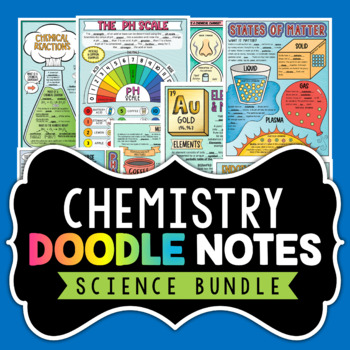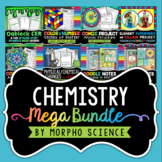Chemistry Doodle Notes Bundle - Atoms, States of Matter, Chemical Reactions
Morpho Science
6.8k Followers
Grade Levels
6th - 8th, Homeschool
Subjects
Resource Type
Standards
NGSSMS-PS1-4
NGSSMS-PS1-2
NGSSMS-PS1-1
Formats Included
- Zip
Morpho Science
6.8k Followers
What educators are saying
Doodle notes are awesome! I enjoy coloring and many of my students do as well. Gives more than one way to see information.
I created a video of myself filling these Doodle Notes in and is now a staple of my classroom for years to come. Students find them challenging with coloring.
Products in this Bundle (10)
showing 1-5 of 10 products
Also included in
- Engaging Chemistry Activities for Teens and TweensThis is a massive bundle of my most popular chemistry resources. This package contains a mix of science labs, doodle notes, foldables, color-by-numbers, worksheets, and projects at a BIG SAVINGS!────────────Let's stay connected!⭐ Follow My TPT Store⭐Price $95.00Original Price $138.85Save $43.85
Description
This bundle includes all of my chemistry doodle notes. Each activity includes a two-page visual note spread with multiple versions for differentiation and a slideshow presentation. Click the preview to see a closer look.
Currently Included in the Bundle:
- Atoms (atomic structure and atomic theory)
- Atoms and Molecules
- Elements Compounds and Mixtures
- Density
- Counting Atoms
- States of Matter
- Changes in Matter (physical and chemical changes)
- Chemical Reactions
- Types of Chemical Reactions
- Acids, Bases, and the pH Scale
────────────
Let's stay connected!
────────────
Copyright © Morpho Science
Doodle Notes is a trademarked term used with permission. Please visit doodlenotes.org for more information.
Total Pages
Answer Key
Included
Teaching Duration
N/A
Report this resource to TPT
Reported resources will be reviewed by our team. Report this resource to let us know if this resource violates TPT’s content guidelines.
Standards
to see state-specific standards (only available in the US).
NGSSMS-PS1-4
Develop a model that predicts and describes changes in particle motion, temperature, and state of a pure substance when thermal energy is added or removed. Emphasis is on qualitative molecular-level models of solids, liquids, and gases to show that adding or removing thermal energy increases or decreases kinetic energy of the particles until a change of state occurs. Examples of models could include drawings and diagrams. Examples of particles could include molecules or inert atoms. Examples of pure substances could include water, carbon dioxide, and helium.
NGSSMS-PS1-2
Analyze and interpret data on the properties of substances before and after the substances interact to determine if a chemical reaction has occurred. Examples of reactions could include burning sugar or steel wool, fat reacting with sodium hydroxide, and mixing zinc with hydrogen chloride. Assessment is limited to analysis of the following properties: density, melting point, boiling point, solubility, flammability, and odor.
NGSSMS-PS1-1
Develop models to describe the atomic composition of simple molecules and extended structures. Emphasis is on developing models of molecules that vary in complexity. Examples of simple molecules could include ammonia and methanol. Examples of extended structures could include sodium chloride or diamonds. Examples of molecular-level models could include drawings, 3D ball and stick structures, or computer representations showing different molecules with different types of atoms. Assessment does not include valence electrons and bonding energy, discussing the ionic nature of subunits of complex structures, or a complete depiction of all individual atoms in a complex molecule or extended structure.



